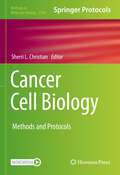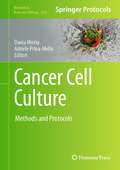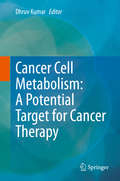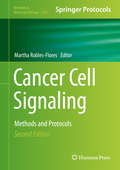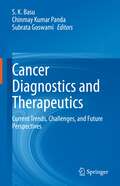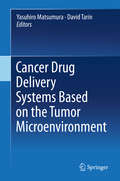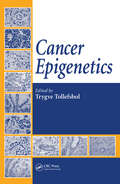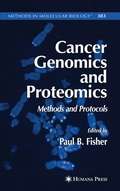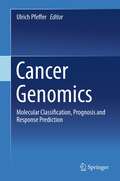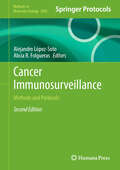- Table View
- List View
Cancer Cell Biology: Methods and Protocols (Methods in Molecular Biology #2508)
by Sherri L. ChristianThis volume provides detailed methods on the mechanisms of underlying cancer cell biology. Chapters guide readers through techniques for culturing cancer cell lines, xenografts, cryopreservation of tumor cells, analyzing the co-culture of breast cancer cells, protein secretion by ELISA, flow cytometry-based, multi-parametric immunofluorescence analysis, protein expression by western blot, analysis of surface protein levels, protein recycling by biotinylation assay, and proteomics analysis by liquid chromatography-mass spectrometry. Written in the format of the highly successful Methods in Molecular Biology series, each chapter includes an introduction to the topic, lists necessary materials and reagents, includes tips on troubleshooting and known pitfalls, and step-by-step, readily reproducible protocols. Authoritative and cutting-edge, Cancer Cell Biology: Methods and Protocols aims to provide a comprehensive set of tools for the analysis of cancer cell biology in the lab.
Cancer Cell Culture: Methods and Protocols (Methods in Molecular Biology #2645)
by Dania Movia Adriele Prina-MelloThis volume explores the latest collection of cell models that are used in preclinical cancer research, and covers both two-dimensional and three-dimensional culturing techniques. The chapters in this book are divided into two parts. Part One discusses two-dimensional cancer cell culture, cell models at the Air-Liquid Interface, and the latest advancements in three-dimensional complex spheroid models and dedicated disease animal models. Part Two contains technical chapters that illustrate step-by-step methodologies for specific cancer cell culture methods. The methods discussed range from the generation of isogenic cancer cell lines, the use of serum-free growth conditions, and three-dimensional cell cultures and their specific assays for the efficacy assessment of new anticancer therapies. Written in the highly successful Methods in Molecular Biology series format, chapters include introductions to their respective topics, lists of the necessary materials and reagents, step-by-step, readily reproducible laboratory protocols, and tips on troubleshooting and avoiding known pitfalls.Cutting-edge and comprehensive, Cancer Cell Culture: Methods and Protocols is a valuable tool to help researchers involved in this important field to further improve or advance their models for cancer research.
Cancer Cell Culture: Methods and Protocols (Methods in Molecular Biology #731)
by Ian A. CreeWith many recent advances, cancer cell culture research is more important than ever before. This timely edition of Cancer Cell Culture: Methods and Protocols covers the basic concepts of cancer cell biology and culture while expanding upon the recent shift in cell culture methods from the generation of new cell lines to the use of primary cells. There are methods to characterize and authenticate cell lines, to isolate and develop specific types of cancer cells, and to develop new cell line models. Functional assays are provided for the evaluation of clonogenicity, cell proliferation, apoptosis, adhesion, migration, invasion, senescence, angiogenesis, and cell cycle parameters. Other methods permit the modification of cells for transfection, drug resistance, immortalization, and transfer in vivo, the co-culture of different cell types, and the detection and treatment of contamination. In this new edition, specific emphasis is placed on safe working practice for both cells and laboratory researchers. These chapters contain the information critical to success - only by good practice and quality control will the results of cancer cell culture improve. Written in the successful Methods in Molecular BiologyTM series format, chapters include introductions to their respective topics, lists of the necessary materials and reagents, step-by-step, readily reproducible protocols, and notes on troubleshooting and avoiding known pitfalls. Authoritative and accessible, Cancer Cell Culture: Methods and Protocols serves as a practical guide for scientists of all backgrounds and aims to convey the appropriate sense of fascination associated with this research field.
Cancer Cell Metabolism: A Potential Target for Cancer Therapy
by Dhruv KumarThis book illustrates various aspects of cancer cell metabolism, including metabolic regulation in solid tumours vs. non-solid tumours, the molecular pathways involved in its metabolism, and the role of the tumour microenvironment in the regulation of cancer cell metabolism. It summarizes the complexity of cancer cell metabolism in terms of the switch from anaerobic to aerobic glycolysis and how mitochondrial damage promotes aerobic glycolysis in cancer cells. The respective chapters provide the latest information on the metabolic remodelling of cancer cells and elucidate the important role of the signalling pathways in reprogramming of cancer cell metabolism. In addition, the book highlights the role of autophagy in cancer cell metabolism, and how metabolic crosstalk between cancer cells and cancer-associated fibroblasts promotes cancer cell progression. In closing, it summarizes recent advancements in drug development through targeting cancer metabolism.
Cancer Cell Signaling: Methods and Protocols (Methods in Molecular Biology #1165)
by Martha Robles-FloresCancer Cell Signaling: Methods and Protocols, Second Edition brings together the most recent advances in cancer cell signaling knowledge along with recent progress in the development of novel strategies and experimental cell models to study human cancer. Opening with a section on targeting cancer cell metabolism as an anticancer strategy, this detailed volume continues with parts describing protocols to study epigenetic control of cancer, protocols to study cancer metastasis, as well as two new techniques for cancer study Written for the highly successful Methods in Molecular Biology series, chapters include introductions for their respective topics, lists of the necessary materials and reagents, step-by-step, readily reproducible laboratory protocols and tips on troubleshooting and avoiding known pitfalls. Authoritative and timely, Cancer Cell Signaling: Methods and Protocols, Second Edition is an ideal guide to the techniques that will aid researchers in exploiting our current knowledge in order to make a profound impact in cancer prevention and treatment.
Cancer Chemoprevention and Treatment by Diet Therapy (Evidence-based Anticancer Complementary and Alternative Medicine #5)
by William C.S. ChoCancer is one of the leading killers in the world and the incidence is increasing, but most cancer patients and cancer survivors suffer much from the disease and its conventional treatments' side effects. In the past, clinical data showed that some complementary and alternative medicine (CAM) possessed anticancer abilities, but some clinicians and scientists have queried about the scientific validity of CAM due to the lack of scientific evidence. There is great demand in the knowledge gap to explore the scientific and evidence-based knowledge of CAM in the anticancer field. With this aim, a book series is needed to structurally deliver the knowledge to readers. Throughout the past few years, the cancer chemopreventive potencies and treatment effects of a number of natural dietary agents present in different food sources have been evaluated by various experiments. Some of them have progressed to early clinical trials. This volume is a specialized book presenting the research evidence relevant to the use of specific diet therapy in cancer chemoprevention and treatment. We begin with lessons learned from dietary resveratrol as an effective agent with anticancer properties against malignancies, followed examples of flavonoids from fruits and vegetables in the prevention and treatment of cancer. Evidence for the beneficial influence of diet enriched with flax seed oil and green tea on cancer will be reviewed. Soy food intake may enhance the effects on anticancer treatment for breast cancer, whereas lycopene-rich foods may possess chemopreventive efficacy. There are also discussions on the contribution of the cancer preventive effects of the antioxidant-rich foods and Mediterranean diet. In addition, the modulation of proteasome pathways by nutraceuticals is highlighted. Finally, we close the book with a discussion on the attenuation of cell survival signaling by bioactive phytochemicals in the prevention and therapy cancer.
Cancer Cytogenetics and Cytogenomics: Methods and Protocols (Methods in Molecular Biology #2825)
by Jing Christine Ye Henry H. HengThis detailed volume explores the frontiers of this new era in cancer cytogenetics and cytogenomics, focusing on establishing a karyotype as an information-based genomic framework, as well as presenting technological platforms for collecting and analyzing data at the genome level. It begins with several conceptual chapters that introduce ideas such as the Genome Architecture Theory, forcefully emphasizing the importance of cytogenomics in the post-genomics era. The book then proceeds with protocols covering both basic and advanced cytogenetic and cytogenomic methods, as well as diverse experiments beyond traditional cytogenetic platforms, and bioinformatics techniques and resources. Written for the highly successful Methods in Molecular Biology series, chapters include introductions to their respective topics, lists of the necessary materials and reagents, step-by-step and readily reproducible laboratory protocols, and tips on troubleshooting and avoiding known pitfalls. Authoritative and up-to-date, Cancer Cytogenetics and Cytogenomics: Methods and Protocols serves as an ideal guide to the unique power of this area of research in spatial biology and system-integrated genomics.
Cancer Cytogenetics: Chromosomal and Molecular Genetic Abberations of Tumor Cells
by Sverre Heim Felix MitelmanThe preeminent book on cancer cytogenetics--now in a valuable new editionLike its successful predecessors, Cancer Cytogenetics, Third Edition continues to offer authoritative coverage of neoplastic processes at the chromosomal level of genomic organization. Now updated and expanded, this new edition includes detailed information on the most recent advances in the field, incorporating a vast amount of new cytogenetic as well as molecular genetic data from the latest basic and clinical investigations.Edited by two leading authorities, who are now aided by a panel of internationalexperts, this new edition has been updated to include:Greatly expanded coverage of solid tumorsEnhanced coverage of acute and chronic myeloproliferative disordersThe latest findings on acute and chronic lymphoproliferative disordersCancer Cytogenetics, Third Edition is a valuable resource for researchers in a wide range of fields, including cytogenetics, medical and molecular genetics, cellular and molecular biology, oncology, and hematology. With its complete coverage of thecytogenetic mechanisms underlying neoplasia, and always with a keen eye on the clinical consequences of the various acquired genetic aberrations, this text will alsobe an indispensable reference for all clinicians involved in the diagnosis and treatment of cancer patients.
Cancer Detection and Diagnosis: A Handbook of Emerging Technologies
by Avraham Rasooly Ben Prickril Miguel OssandonEmerging technologies for cancer detection and diagnosis are providing more and more advance warning of pathologies of clinical significance. Research devoted to cancers are revealing new ways of finding and treating these complex diseases. This volume reviews a broad array of new technologies for cancer detection and diagnosis. While there are several clinical books describing cancer diagnosis, and general molecular analytical technologies, these books are not focused on cancer detection and diagnosis. The aim of this book is to describe emerging cancer detection and diagnosis technologies.Key Features Presents myriad new experimental cancer detection technologies Describes technology so the reader may conduct similar analyses Outlines clinical applications of technology for specific cancer and summarizes results Discusses pitfalls and limitations, future trends and potential technological developments
Cancer Diagnostics and Therapeutics: Current Trends, Challenges, and Future Perspectives
by Subrata Goswami S. K. Basu Chinmay Kumar PandaThis book presents multiple facets of cancer biology, including cancer diagnosis, therapeutics to the latest developments in cancer informatics, and applications of artificial intelligence for improving oncologic care. The initial section of the book discusses factors contributing to the development and causes of cancer. The subsequent sections discuss the basic principle of imaging and therapeutic techniques, including MRI, CT, and positron emission tomography (PET) Scan. The book further, explores the implications of cancer chemotherapy on the immune system and emphasizes the effective management of cancer-related pain. Towards the end, it covers recent advancements in cancer treatment, including targeted therapy, immunotherapy, interventional radiotherapy, and stem cell-based therapy. Lastly, it summarizes essential strategic elements of cancer informatics for improving patient outcome.
Cancer Drug Delivery Systems Based on the Tumor Microenvironment
by Yasuhiro Matsumura David TarinThis book proposes the importance of new systems of drug design and delivery based on cancer pathophysiology in addition to cancer molecular and cellular biology. The current studies based on molecular and cellular biology while ignoring pathophysiology and pharmacology may be leading the development of antitumor drugs in the wrong direction and wasting a lot of money. Although there have been numerous reports of genetic and phenotypic changes in tumors, a large body of pathological and clinical evidence supports the conclusion that there are no pivotal changes in tumor cells that distinguish them consistently and reliably from normal dividing cells. Unlike using antibiotics against bacterial infection, therefore, anticancer agents (ACAs) need to be delivered selectively to tumor tissues and should be kept there long enough to reproduce the concentrations they reach in the Petri dish, which is a closed space where the cytocidal effects of any anticancer agents (ACAs) including molecular targeting agents are very strong. In the body, however, administered ACAs are cleared with the passage of time. Furthermore, most human cancers possess abundant stroma that hinders the penetration of drugs into the tumor microenvironment. Therefore, to overcome these difficulties, novel drug delivery systems have been designed, such as nanoparticles and ACA conjugated antibodies to stromal components and to cancer cell surface antigens. These advances are described in this book after the first section, which describes core features of the pathophysiology of the cancer microenvironment, on which these new developments are based.
Cancer Epigenetics
by Trygve TollefsbolDuring the past few decades, it has become increasingly apparent that heredity is not the sole determining factor in disease development, such as cancer. This landmark work covers a wide array of aspects in the relatively new area of epigenetics, ranging from its role in the basic mechanisms of tumorigenesis, to the newest epigenetic drugs being de
Cancer Epigenetics (Epigenetics and Human Health #11)
by Rasime KalkanEpigenetic alterations are heritable changes that play a key role in human development and tissue-specific gene expression patterns. These changes can lead to alterations involved in tumor formation, imprinting, and metabolic disorders. Recent advances can help us understand the importance of epigenetic changes in both cancer development and tumor progression. In addition, epigenetic alterations may also be useful diagnostic and prognostic markers for the analysis of tumor progression.Split into two parts, the book opens with a comprehensive overview of the identification and analysis of epigenetic changes in cancer and the consequences of such changes during tumor development. The second part focusses on cancer specific epigenetic alterations and discusses the potential use of epigenetic markers as biomarkers in diagnosis, early cancer progression, and prognosis. Moreover, it reviews the therapeutic potential of epigenetic drugs. Given its scope, Cancer Epigenetics is an indispensable resource not only for researchers working in the field of human epigenetics and cancer research but also for advanced students seeking for an introduction into epigenetic mechanisms.
Cancer Epigenetics: Risk Assessment, Diagnosis, Treatment, and Prognosis (Methods in Molecular Biology #1238)
by Mukesh VermaThe epigenetic regulation plays an important role in normal development and maintenance of tissue specific genes expression in humans and the disturbance of these patterns lead to changes involved in tumor formation. More recently, epigenetic changes have been observed in early stages of tumor development and together with the genetic alterations have been defined as abnormalities, necessary for cancer initiation and progression. In, Cancer Epigenetics: Methods and Protocols, expert researchers reviewed these epigenetics changes in different tumor types and described several technologies that are currently available to detect epigenetic changes. These technologies have lead to a better understanding of the processes in normal and cancerous cells. Written in the highly successful Methods in Molecular Biology(tm) series format, the chapters include the kind of detailed description and implementation advice that is crucial for getting optimal results in the laboratory. Thorough and intuitive, Cancer Epigenetics: Methods and Protocols aids scientists in continuing to study epigenetic alterations used in clinical practice as biomarkers of early cancerous lesions or markers of progression and prognosis.
Cancer Genomics and Proteomics: Methods and Protocols (Methods in Molecular Biology #1176)
by Narendra WajapeyeeCancer Genomics and Proteomics: Methods and Protocols, Second Edition includes methods for the analyses of cancer genome and proteome that have illuminated us about the changes in cancer cells. Written in the highly successful Methods in Molecular Biology series format, chapters include introductions to their respective topics, lists of the necessary materials and reagents, step-by-step, readily reproducible laboratory protocols, and key tips on troubleshooting and avoiding known pitfalls. Authoritative and practical, Cancer Genomics and Proteomics: Methods and Protocols, Second Edition seeks to aid scientists in the further study into various aspects of tumor initiation and progression.
Cancer Genomics and Proteomics: Methods and Protocols (Methods in Molecular Biology #383)
by Paul B. FisherCancer Genomics and Proteomics provides a compendium of techniques and applications in gene identification and function. The approaches described in detail are state-of-the art and can be tailored to individual ongoing or planned research projects. This volume is a valuable laboratory resource for designing experiments to identify and analyze genes that are relevant to complex biological phenomena.
Cancer Genomics: Molecular Classification, Prognosis and Response Prediction
by Ulrich PfefferThe combination of molecular biology, engineering and bioinformatics has revolutionized our understanding of cancer revealing a tight correlation of the molecular characteristics of the primary tumor in terms of gene expression, structural alterations of the genome, epigenetics and mutations with its propensity to metastasize and to respond to therapy. It is not just one or a few genes, it is the complex alteration of the genome that determines cancer development and progression. Future management of cancer patients will therefore rely on thorough molecular analyses of each single case. Through this book, students, researchers and oncologists will obtain a comprehensive picture of what the first ten years of cancer genomics have revealed. Experts in the field describe, cancer by cancer, the progress made and its implications for diagnosis, prognosis and treatment of cancer. The deep impact on the clinics and the challenge for future translational research become evident.
Cancer Hazards: The 2015 IARC Classifications: Implications for Regulation, Environmental Justice, and Global Health (AESS Interdisciplinary Environmental Studies and Sciences Series)
by Martha RichmondThis book focuses on a monograph published in 2017 by the International Agency for Research on Cancer (IARC), an agency of the World Health Organization (WHO), discussing its carcinogen hazard classification of four pesticides: parathion, malathion, diazinon, and tetrachlorvinphos as well as the herbicide glyphosate. The monograph provided a detailed discussion of considerations and conclusions made by a group of experts who met in 2015 to evaluate these compounds. Although not universally true, many of these substances, from the time of their commercial introduction to their present-day use, have spread significantly in the environment, affecting animals and plants in the larger ecosystem, the overall health of the environment, and human health. This book develops each of these issues before turning to the IARC review process, both the general process and its evolution over time, and compound selection criteria and deliberations regarding the substances discussed in the 2017 monograph. Final book sections detail scientific and private sector reactions to and implications of the IARC classifications. Hazard identification is contrasted with various models of quantitative risk assessment. The last chapters highlight the importance of hazard identification for members of domestic and global underserved communities involved in farming and landscape work, where exposures may vary widely, are not well-regulated, and where health outcomes are often not carefully documented.
Cancer Immunosurveillance: Methods and Protocols (Methods in Molecular Biology #2930)
by Alejandro López-Soto Alicia R. FolguerasThis new edition explores the innovation and improvement of experimental techniques harnessed to dissect the complex relationship between cancer cells and the immune system of the host. Beginning with spectral and multicolor flow cytometric methods to characterize the immune contexture of different forms of metastases, the book continues with functional assays to study the activation status of immune cells with antitumor properties, bioinformatic approaches of interest for cancer immunology research, techniques for performing epigenetic studies, as well as methods related to translational research. Written for the highly successful Methods in Molecular Biology series, chapters include introductions to their respective topics, lists of the necessary materials and reagents, step-by-step and readily reproducible laboratory protocols, and tips on troubleshooting and avoiding known pitfalls. Authoritative and up-to-date, Cancer Immunosurveillance: Methods and Protocols, Second Edition serves as a valuable resource for scientists seeking inspiration for new ideas and research in the field of tumor immunology.
Cancer Immunotherapies: Solid Tumors and Hematologic Malignancies (Cancer Treatment and Research #183)
by Priya HaysThis book presents the clinical scope of cancer immunotherapeutic agents for solid tumors and Hematologic malignancies, elaborates on the scientific details of their modes of action, and presents the impact of these agents on oncology, patients and the broader healthcare system. At present, cancer immunotherapies fall broadly into three categories: immune checkpoint inhibitors (ICIs), adoptive T cell therapies, and cancer vaccines which have distinct mechanisms of action. Immune checkpoint inhibitors rely upon disrupting tumor antigen recognition as self by the immune system through inhibition of checkpoint molecules. Adoptive T cell therapies involve the engineering of T cells ex vivo to target and destroy tumor cells.The first part of this book will provide an overview of the discovery and mechanistic details of the technology. The second part will be devoted to elaborating on the clinical outcomes, successes and limitations for specific tumor subtypes, which includes both solid tumors and hematologic malignances for both pediatric and adult populations. As such, the book offers a valuable resource for oncologists, hematologists, and all those seeking an up-to-date overview of cancer immunotherapies.
Cancer Immunotherapy and Nanobiotechnology: An Interdisciplinary Approach (Interdisciplinary Cancer Research #25)
by Nima RezaeiThe “Cancer Immunotherapy and Nanobiotechnology: An Interdisciplinary Approach” is the twenty fifth volume of the “Interdisciplinary Cancer Research” series, publishes comprehensive volume on cancer immunotherapy and nanobiotechnology. The volume starts with chapters on targeting mitochondria in cancer immunotherapy, immunotherapy in oncology, and cancer treatments through immunological pathways. Immune checkpoint inhibitors as well as engineered iPSC-based strategies are explained in other chapters after discussion on cancer stem cells. CAR NK, CAR T cells, and DC therapy are the subjects of the following chapters. Then tumor microenviroment in response to immunotherapy and T-cell responses during cancer immunotherapy through the use of imaging are explained. The second half of the volume is focused on application of nanobiotechnology in cancer, starting with general chapters on nanotechnology for cancer research, nanotechnology and cancer therapy strategies, nanomedicine based cancer immunotherapy, applications of nanocarrier systems in cancer treatment, and nanoformulations in cancer theranostics. Then the role of metal nanomaterials in cancer therapy, synthetic drug nanodelivery systems, nanoparticles loaded with cytotoxic agents, nanocarrier-mediated drug delivery, vesicular nanosystem, and nanoscale metal-organic frameworks for cancer-targeted therapy are explained. This is the main concept of Cancer Immunology Project (CIP), which is a part of Universal Scientific Education and Research Network (USERN). This interdisciplinary book will be of special value for those who wish to have an update on cancer immunotherapy and nanobiotechnology.
Cancer Inhibitors from Chinese Natural Medicines
by Jun-Ping XuNature is an attractive source of therapeutic and preventive compounds, and with such chemical diversity found in millions of species of plants, over 60% of currently used anticancer agents are derived from natural sources. Cancer Inhibitors from Chinese Natural Medicines summarizes new advancements in the experimental and clinical research of a selection of promising cancer inhibitors. It focuses on the latest scientific investigations of 238 Chinese herbs and discusses important aspects, including the types of inhibitors in the herbs, level of potency, mechanisms, and the advances in modification and formulation. Formulations from nano-particulates and immunotoxins in cancer inhibitors are also included in this comprehensive resource.
Cancer Metabolomics: Methods and Applications (Advances in Experimental Medicine and Biology #1280)
by Shen HuCancer metabolomics is a rapidly evolving field that aims for a comprehensive dissection of the metabolic phenotypes and functional network of metabolites in human cancers. State of the art metabolomics tools have been developed and applied to studying cancer metabolism and developing metabolic targets for improved diagnosis, prognosis and therapeutic treatment of human cancers. Chapters are written by subject experts in the field of cancer metabolomics with cross-disciplinary contributions. Coverage includes advanced metabolomics technologies and methodologies, including chemical isotope labelling liquid chromatography - mass spectrometry, capillary ion chromatography - mass spectrometry, 2-D gas chromatography – mass spectrometry, capillary electrophoresis – mass spectrometry, nuclear magnetic resonance spectroscopy, shotgun lipidomics, tracer-based metabolomics, microbial metabolomics, mass spectrometry imaging for single cell metabolomics and functional metabolomics. In addition, the book highlights new discoveries in cancer metabolism such as hypoxia inducible factor pathway, isocitrate dehydrogenase 1 mutation and oncometabolites. Finally, contributors focus on the translational applications of metabolomics in human cancers such as glioma, head and neck cancer, and gastric cancer. This new volume will be a unique reference source for cancer researchers and promote applications of metabolomics in understanding cancer metabolism.
Cancer Mortality and Morbidity Patterns in the U.S. Population: An Interdisciplinary Approach (Statistics for Biology and Health)
by Julia Kravchenko Igor Akushevich K. G. MantonThe purpose of this book is to examine the etiology of cancer in large human populations using mathematical models developed from an inter-disciplinary perspective of the population epidemiological, biodemographic, genetic and physiological basis of the mechanisms of cancer initiation and progression. In addition an investigation of how the basic mechanism of tumor initiation relates to general processes of senescence and to other major chronic diseases (e.g., heart disease and stroke) will be conducted.
Cancer Nanotechnology: Principles and Applications in Radiation Oncology (Imaging in Medical Diagnosis and Therapy)
by Sunil Krishnan Sang Hyun ChoRapid advances in nanotechnology have enabled the fabrication of nanoparticles from various materials with different shapes, sizes, and properties, and efforts are ongoing to exploit these materials for practical clinical applications. Nanotechnology is particularly relevant in the field of oncology, as the leaky and chaotic vasculature of tumors-a
